And the Real Treasure of Treasure Island
Chris and I left Ventura, California, on September 17th 2022, with a southern wind on our tail and unknown adventure on the horizon. After two days and seven hours of nonstop sailing up the California coast, we found solace in San Francisco Bay’s Clipper Cove, located between Treasure and Yerba Buena Island. Here, we set the hook for our first night of much needed rest.
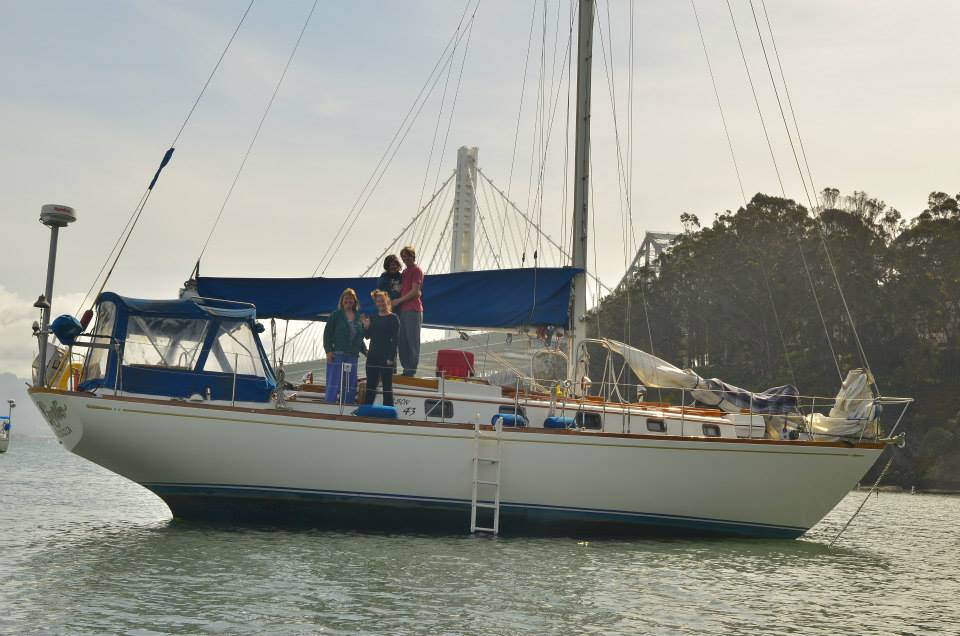
Mama Neely, Shannon, 15 year old Marissa and Chris aboard Sea Castle, that was run aground when the tide went out.
It was somewhat ironic that this was our first destination on our cruising journey. Many years prior, I had my first overnight anchoring experience aboard Chris’s mom’s boat, Sea Castle, at Clipper Cove, with the whole Neely Armada present. Little did I know that eight years later, I would be returning aboard my own boat.
Considering that there are many shoals and unmarked hazards in “The Bay,” it’s always best to check with local sources regarding the best anchorage entry tactics. Fortunately, Chris’s sister-in-law, Shannon, had written about “the cut” of Clipper Cove on Prism’s Blog Site, which we referenced to vicariously guide us through the shallows to the deep water where we would safely set our hook.
Getting into the anchorage definitely proved a bit difficult, especially as a deep-keeled vessel like Avocet with a 6.5’ draft, since a shoal guards most of the entrance at low tide. With that said, sailors will want to wait until the flood current returns, as similar drafted vessels need enough clearance to navigate the channel into the anchorage.
In her blog post, Shannon recommends hugging the pier on our starboard side and, once almost to the sailing dinghy dock, pointing our bow directly at the TransAmerica pyramid building (a tall pointed structure) in the distance. By then, Avocet was passing right over the shoal, so Chris and I kept a close eye on our depth and saw a minimum of two feet under the keel. The good news: once we were over the shoal, the depth gradually increased, and we set our hook in a comfortable 16 feet of water. Reluctantly, we actually had to reset the hook after our first attempt, since we had applied the same tried-and-true methods from Southern California.
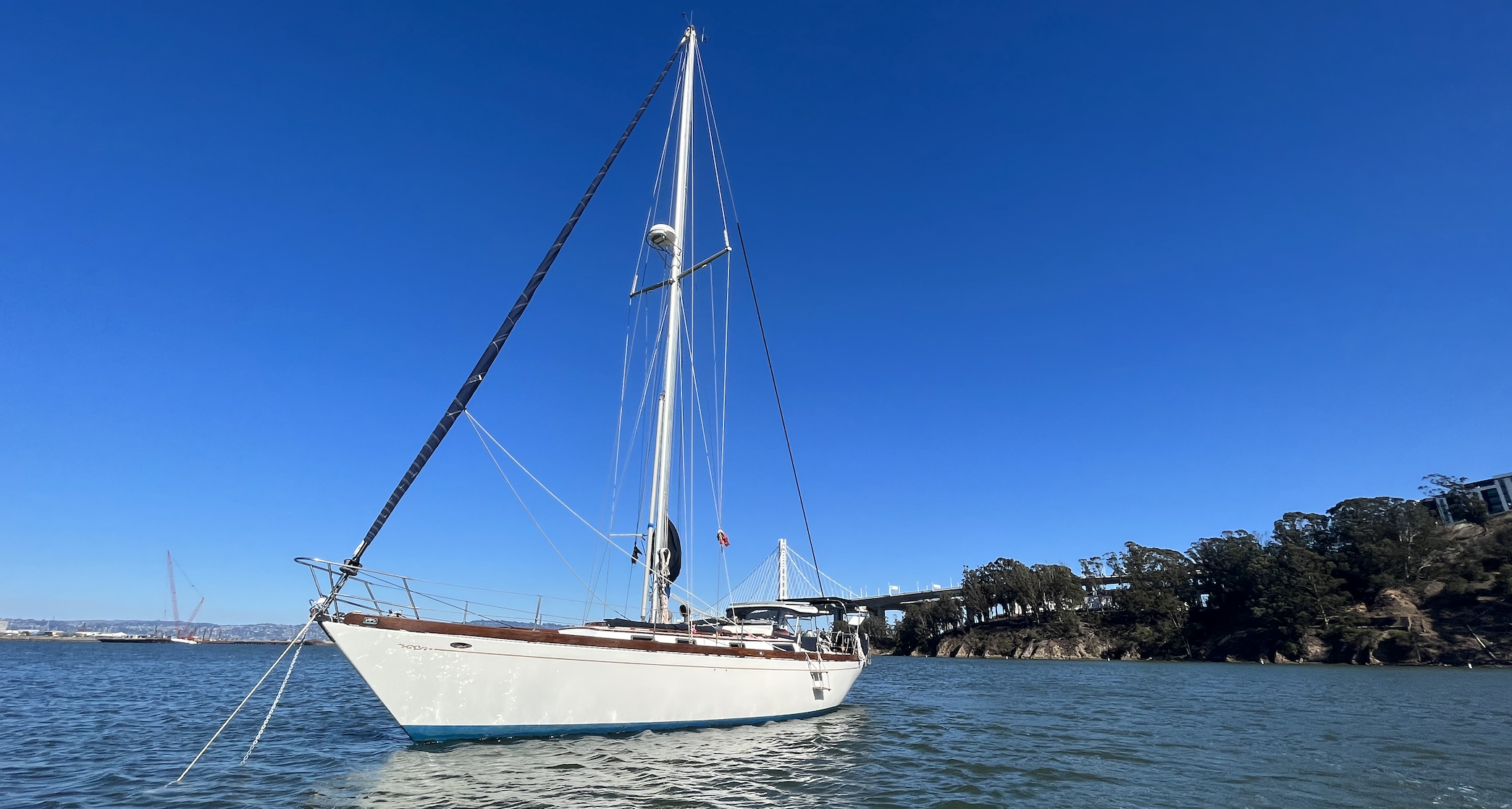
*Do not enter the anchorage from the south (near the bay bridge)! It is VERY shallow!
Here is where we went wrong: Chris dropped our anchor, a 55 pound Rocna Vulcan, while the boat was idle and paid out a 4:1 scope, then signaled for me to put the engine in reverse. Avocet moved back, gaining speed as the chain on the seabed was pulled back from where it was dropped. About 50 feet back, Avocet came to the end of her scope abruptly, which blew the anchor out of the mud as we began to drag.
In the Channel Islands and Southern California area, we were accustomed to sandy holdings, which are arguably the easiest ground to set an anchor in. However, in the soft and silty Bay Area mud, the substrate sticks to the fluke of the anchor, turning a very intentional and specifically designed shape into a giant mud ball with no chance of gripping into the ocean floor.
After realizing our error, we quickly corrected our methods by resetting with more scope (7:1), then gradually paying out the chain, softly coming to the end of our scope. Once the chain was taut, we backed down on our hook. We usually bring our engine up to about 2500 RPMs, which is the equivalent (with our prop) to about a 30-40 knot winds, sustained. Once we were positive that we weren’t dragging, it was time to relax – which is easy in Clipper Cove.
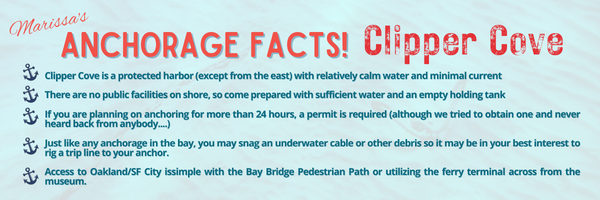
The Lay of the Land
Nestled between the two islands, you will find that the cove provides protection from almost all directions (minus the east) and shelters you from the sounds and views of San Francisco – impressive, given the close proximity. The water was as still as a lake, allowing us to sleep soundly from the early hour of 7:30 PM through 10:00 AM the following day (an unspoken agreement to wake up slowly). When we finally rolled out of our berth, I made a celebratory breakfast of pancakes decorated with fresh fruit and Vermont maple syrup – almost as sweet as our new digs.
The Bay Bridge was on full display behind us, and in front of us was a long sandy beach with no breaking waves, surely making our beach landing a breeze. Another boat, which Chris confidently ID’d as an Irwin 46, was anchored closer to shore, becoming our only neighbors for the time being. After breakfast, Chris began to pace around the boat. I had just settled in the cockpit with my coffee and laptop to go over some work emails, but he was clearly going stir crazy from being so still. After a few moments of patiently letting him buzz around me, I suggested we launch the dinghy so he could go to shore with his bike and scope out the island.
The sound of construction and traffic formed an urban symphony; my incessant typing, the metronome. Hours passed with no word from Chris, leaving me a bit concerned. Had he crashed? My anxiety began to set in, and the only cure was the reassurance that my accident-prone partner was alive and in one piece. “So I learned something new,” a very winded (but still breathing) Chris began to explain through the phone. Apparently, the Bay Bridge pedestrian path was only available on the weekends… and it was a Thursday, meaning he had pedaled all the way up to the top of Yerba Buena Island for no reason other than a good workout. Chris (somehow) returned more energized than when he left, eager to get me to shore and tour the island with me on foot.
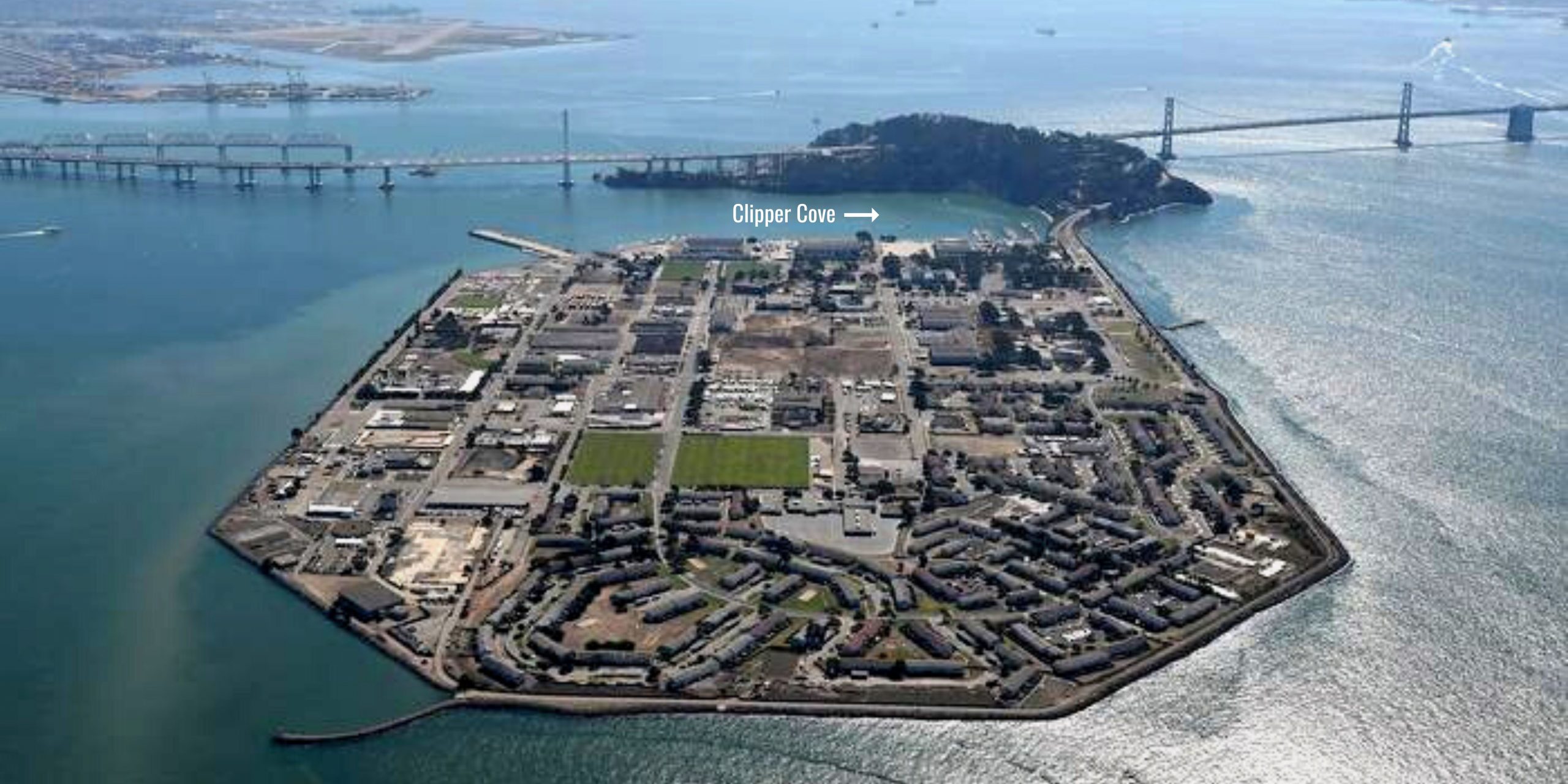
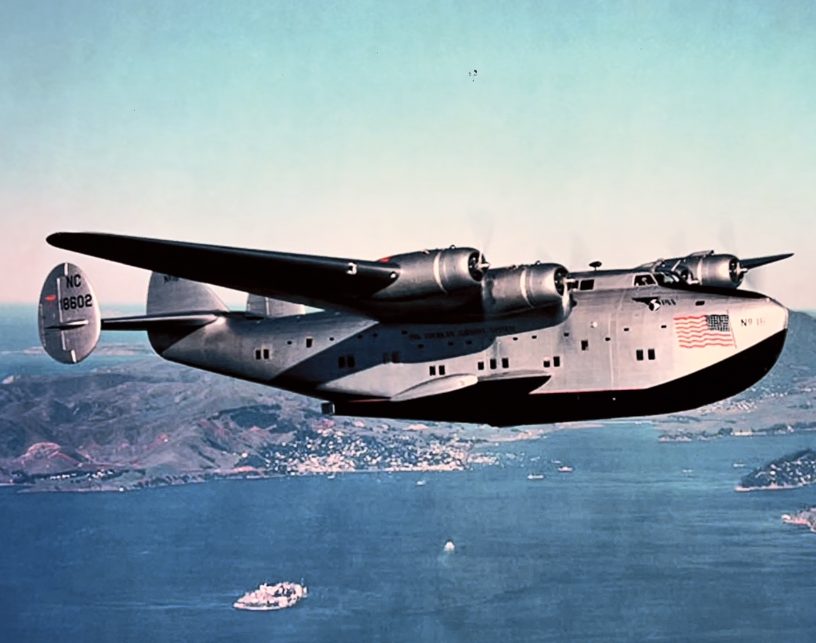
The PanAm Clipper
From the air, you will notice that Treasure Island is flat in comparison to Yerba Buena, the island it is loosely connected to by a two way road – that is because Yerba Buena Island is an organic land mass whereas Treasure Island was artificially created. The 400-acre island was built by the Army Corps of Engineers in 1936-37 on the shoals of Yerba Buena in anticipation of the 1939 World Fair. The site of the fair was to later become San Francisco International Airport, but the Navy seized the island in 1942, shortly after World War II began, and it became Treasure Island Naval Station. Pan American World Airways’ Clipper seaplane was commonly used at the time, and for which Clipper Cove gained its name.
Chris and I walked along the island’s perimeter on a clearly marked pedestrian path with an unmatched view of the Golden Gate Bridge and the city. I was surprised to see that the island wasn’t more developed, mirroring the towering buildings and new age homes that the surrounding cities sported, but instead hosted many of the original buildings created for military personnel. Given the jaws of capitalism and the growing housing crisis in the Bay, this spit of land seemed like an extremely underutilized opportunity, so what gives? After a little google search we discovered that although the Navy left the island in 1997, their messy legacy remained.
A little over twenty years ago, the city of San Francisco moved thousands of its homeless and low-income residents into former military housing on Treasure Island, after the Navy base left it covered in toxic radiation. Today, construction on the island has it on track to becoming a bustling, upscale extension of the city. The problem is, some of those residents from twenty-something years ago are still there, as well as thousands of others who have moved in since… oh, and so is the radiation.
To date, the Navy’s $285.1 million Treasure Island cleanup has unearthed concentrations of lead, dioxins, petroleum and more than 1,000 radioactive items. Among other activities, the Navy had used the island to repair ships with deck markers painted with radium. For years the Navy dumped radioactive material and other contaminants in large garbage pits that have since been developed over. Chris and I walked past the corner of Avenue E and 11th Street, where the Navy discarded used equipment and vessels in what they called the “South Storage Yard,” but today that dumping ground is an elementary schoolyard. On the corner of Avenue D and 11th Street, where the island’s daycare center is now located, the Navy buried trash and “burned debris.”
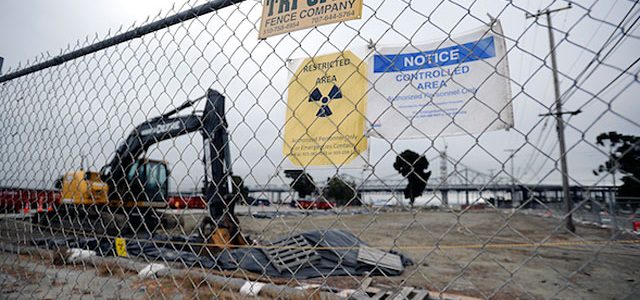
Photo: KQED
As we walked past these noted dumping grounds, my skin crawled with the idea that children were being carelessly exposed to such horrors for years without any acknowledgement from the government. The effects of this mass exposure aren’t widely known (yet) but the contamination has had clear social and economic consequences, such as delaying a city blueprint to provide quality housing.
While Treasure Island’s name implies that there was something of value buried beneath the soil it was resurrected from, I couldn’t help but think that radioactivity lies beneath where “X” marks the spot. The wind carried the sound of children’s laughter from a playground in the distance as we walked back to Avocet that evening, dismally carrying our newfound knowledge with us.
Sailors Take the City
One of our favorite parts about anchoring in Clipper Cove is the accessibility to the surrounding cities. Once the dinghy was easily beached and locked to a tree we walked over to the new ferry station that had just opened March of 2022 in an attempt to entice more visitors to the generally overlooked island. A round trip ride to and from the city was $20 for the two of us, and we felt very VIP as the only passengers aboard both ways. The crew was very kind, welcoming us aboard with big smiles and pleasant conversation.
My prior experiences in the city were pretty much limited to San Francisco Giants baseball and 49’er football games with my family, but Chris was a wealth of knowledge sharing the city’s history – and what he couldn’t recite from memory he was a whiz at reading from Google.
Chris’s San Fran Facts:
San Francisco is the commercial, financial, and cultural center of Northern California. The city is the fourth most populous in California and 17th most populous in the United States, with 815,201 residents as of 2021 making it the second most densely populated large U.S. city after New York City. The cultural diversity in San Francisco has made it a safe area for everyone from Muslims to Asians and African Americans and from Mexican to Chinese and Japanese people. Oh, and the city has more dogs than children. Despite being 95% developed, the city contains dozens of natural ecological communities, harboring an astounding diversity of birds, mammals, reptiles and amphibians, rare and endangered species, and over 450 native plants (which is something we got to experience, and will write about in an upcoming blog!)
San Francisco has 43 hills ranging upward from 200 to 938 feet and I am confident we walked up at least half of them. After a full day of playing tourist and sightseeing, we clocked 25,600 steps which was 2,200 more than our biggest walking day in Italy last May.
While waiting for the ferry to arrive at the terminal, we spent our time walking through the Ferry Building Market, which lies beneath the dramatic clock tower that has been the icon of the San Francisco waterfront for more than a 100 years.
Opening in 1898, the Ferry Building became the transportation focal point for anyone arriving by train. From the Gold Rush until the 1930s, arrival by ferryboat became the only way travelers and commuters – except those coming from the Peninsula – could reach the city. Passengers off the boats passed through an elegant two-story public area with repeating interior arches and overhead skylights. At its peak, as many as 50,000 people a day commuted by ferry. The opening of the bridges, along with mass use of the car, rendered the daily commute by ferryboat obsolete. By the 1950’s, the Ferry Building was used very little. The historic interior of the Ferry Building structure was lost in 1955, when much of the building was converted to standard office space. The double-deck Embarcadero Freeway also cast its shadow for 35 years, until the 1989 Loma Prieta Earthquake.
The Ferry Building Marketplace is a world class public food market that is organized along an indoor street, “the Nave,” and filled with incredible fares and wares. Amongst the delicious smells and interesting trinkets was a mushroom shop that had virtually every type of mushroom available (no, not that kind) and at a very reasonable price. I was giddy as I sifted through their mushrooms, brown bagged for safety, in their cold box while I directed Chris to their dried goods to see if he could find any dried truffle for under $50/ounce. He was unsuccessful, but I was victorious as we left with a large bag of Brown Buttons and Trumpets for under $10, a steal considering at the store it would have easily been a $30 purchase!
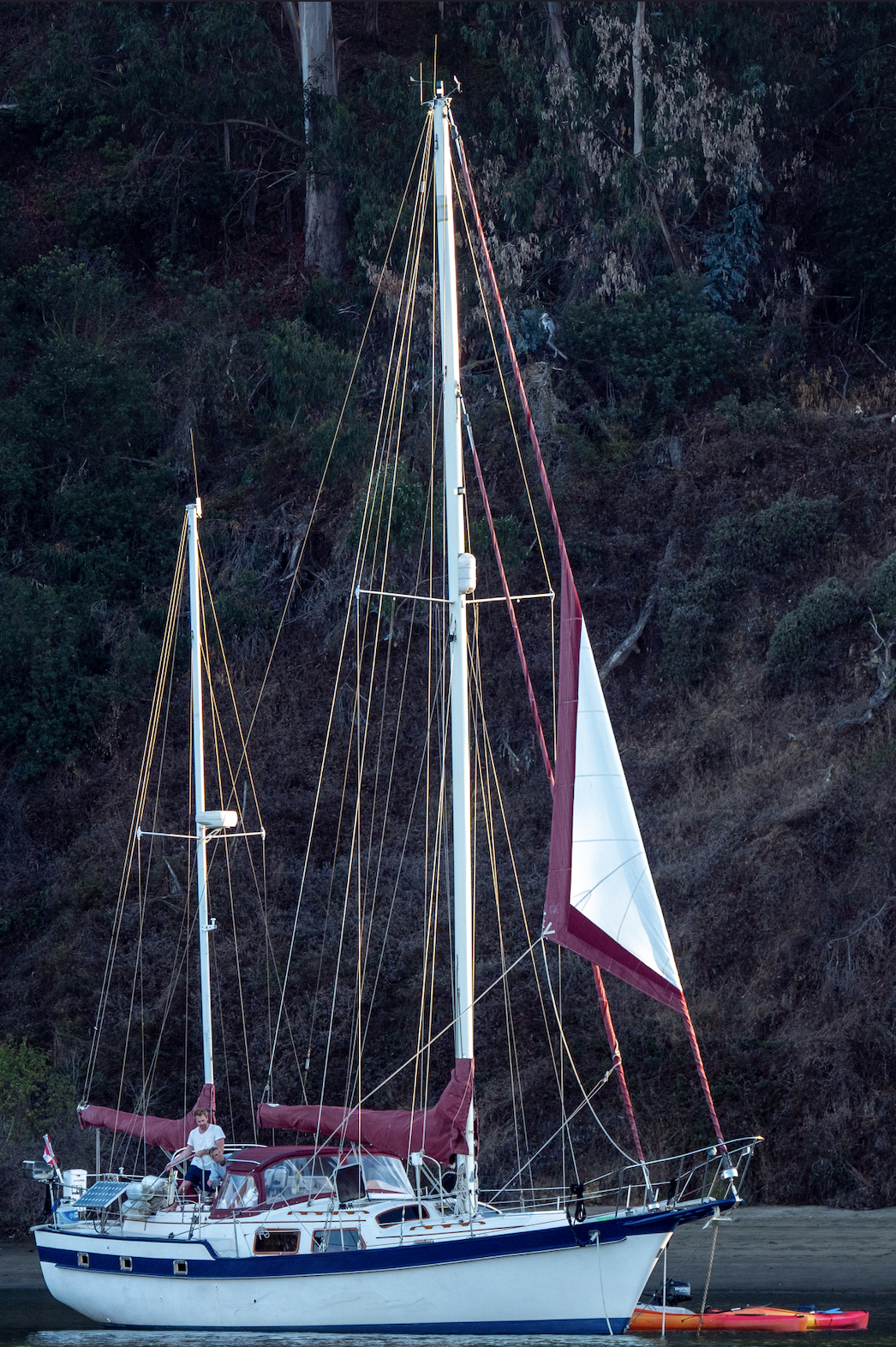
Our new friends
After another VIP ferry ride to the island we walked along the sandy shoreline to where we stashed Winglet. A young woman was walking in front of us, undoubtedly our anchorage neighbor aboard Chalet Mer. I have never been one to confront strangers, a slave to my shyness, so we said a quick hello in passing and watched her uncover her kayak from a very strategic hiding spot. We were truly amazed how she kept her bright orange kayak hidden amongst the shoreline shrubbery, which warranted a follow up introduction.
“We don’t watch hockey and we don’t speak French” the couple laughed from their cockpit, their Canadian flag billowing off the transom in the afternoon winds. Chris later grilled me for asking the most generic thing you could ever ask a Canadian. “I was genuinely curious” I would respond, as a hockey fan myself it is always nice to connect with fellow enthusiasts. The couple introduced themselves as Corey and Lucy, two Canadian born SF bay locals that live aboard Chalet Mer. We exchanged pleasantries and laughs before they invited us over later in the evening for wine to talk all about boat life and the journey so far. That evening, we became very fast friends.
Playing into the Stereotype
There is a common saying that cruising is just “fixing things in exotic places” and although San Francisco is not what many would consider “exotic” it is still known as the concrete jungle and that is close enough for me. During our transit up the coast we had a few failures, but perhaps the most embarrassing was ripping a hole in our mainsail. Since Clipper Cove was so still, we felt comfortable bringing out the sewing machine and lowering the sail to do some patchwork and assess the sail’s entire wellbeing.
What started as a two hour project quickly turned into an entire day affair when our beloved Thompson Sailrite sewing machine decided to protest. Our machine is only meant to do straight stitching on canvas, but what we needed it to do was sew through six layers of eight ounce dacron. Eventually Chris and the machine found a compromise, which was taking it slow and going over the stitches a few times to ensure the patch would hold. I was wrapped in the stomach of our sail on deck, keeping the wind from blowing it away when I noticed that boats were beginning to fill the anchorage, forming a raft up off our bow.
The (Unofficial) Washed Up Yacht Club is an eclectic group of sailors and boats that come together once a month (or more!) to raft up at Clipper Cove for good old fashion comradery. Funny enough, Chris’s brother was one of the founders of the club way back when they were still sailing aboard their Caliber 28’, Tara, and since his involvement it has tripled in size! Our friends Scott and Ashley that we met down in Ventura when they were sailing south were members of the club, and when they noticed we would be in the cove during the annual raft up Ashley reached out to make some introductions through WhatsApp – the sailing community is so strong, even when your pals are 2885 nautical miles away.
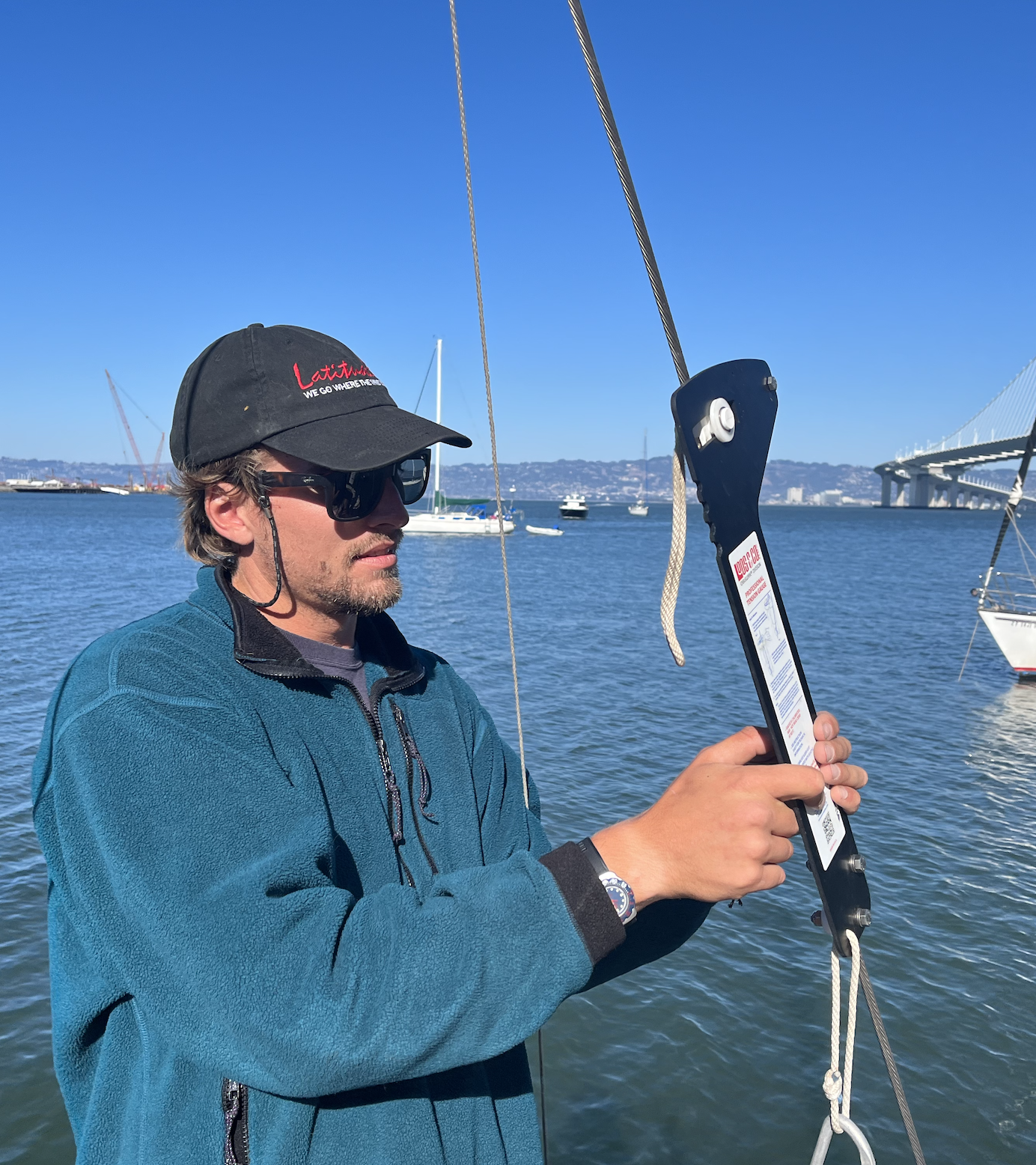
Chris with the rig tensioner
The raft-up grew in size by the minute while Chris remained unbothered by the music, laughter, and smells of food that whafted our way from where the boats floated. My patience was wearing thin as the day continued to fade into the evening, and the only thing we had to show for it was a half-fixed mainsail. Eventually the project did wrap up and we put the sail back in the stackpack before Chris grabbed his tools and loaded up the dinghy. “Let’s go” he said as he motioned towards Chalet Mer in the distance.
During our chat aboard our new-friends-boat the previous evening, Corey had mentioned that his rigging was loose and didn’t know the best way to fix it. Luckily, Avocet is essentially a floating chandlery, complete with a rigging tension gauge that was gifted to us by a Neely family friend. Corey took diligent notes while Chris paced around the deck checking the rigging and servicing turnbuckles, making an assessment on how the rig was currently tensioned before making any changes. After an hour of rig tensioning Corey was kind enough to play bartender and treat us to drinks in the cockpit.
“Is that… a chicken?” I licked the taste of tequila off my lips after the odd question left my mouth. My drink returned to my lap as I looked to my companions for reassurance that my eyes were not betraying me; it was, in fact, a chicken, perched on a dinghy being driven around the anchorage to welcome boats to the raft up. And in that moment I knew that that was a person I needed to meet.
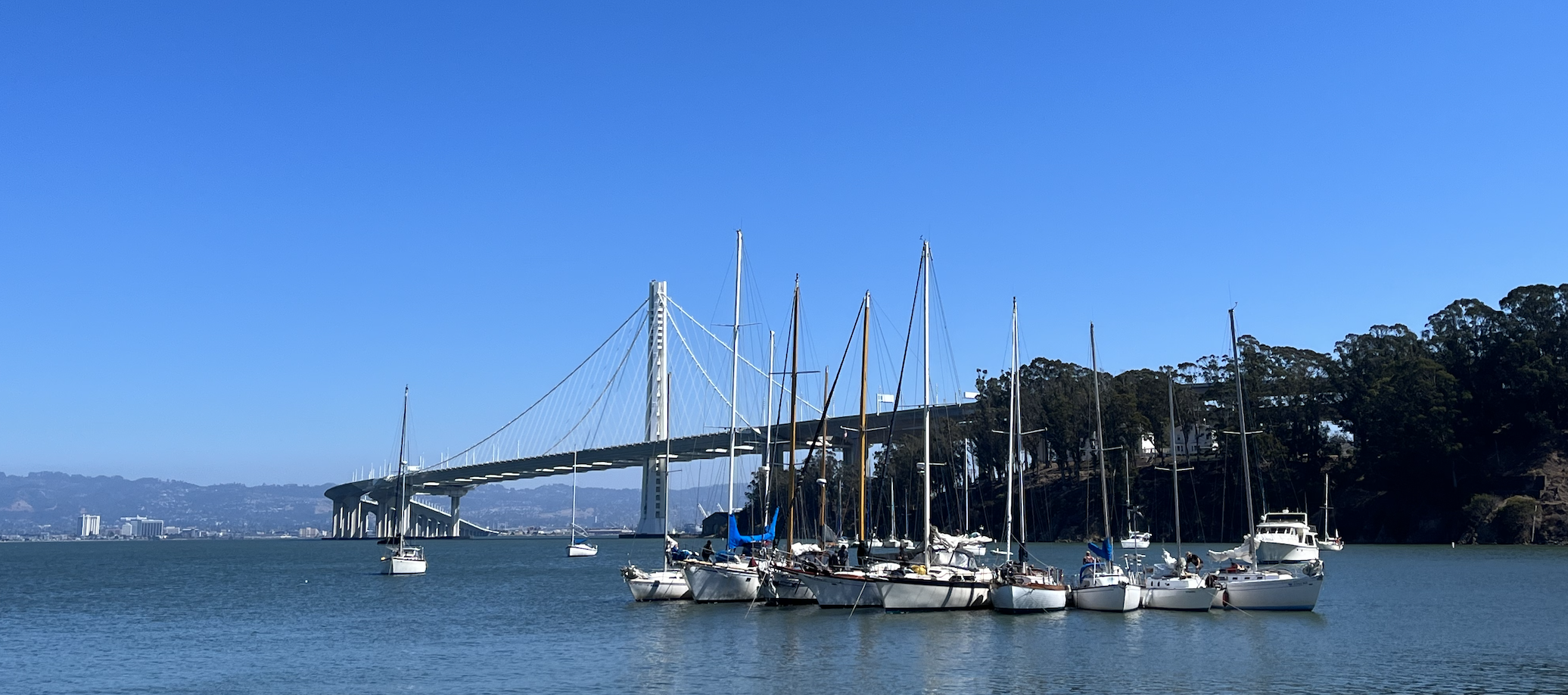
The afternoon melted into nighttime, with salty frigid air biting at any exposed skin. Chris and I loaded up Winglet and made our way over to the very established raft up that had 12 vessels tied together with well over 30 people jumping between them all. “Are we okay to tie up here?” I asked as we squeezed between two other dinghies tied off a Catalina 27. The man aboard said it was no problem and welcomed us to the party, asking where we had come from. We proudly pointed to Avocet, that sat calmly off their stern, with her red deck lights a beacon to which we would later return.
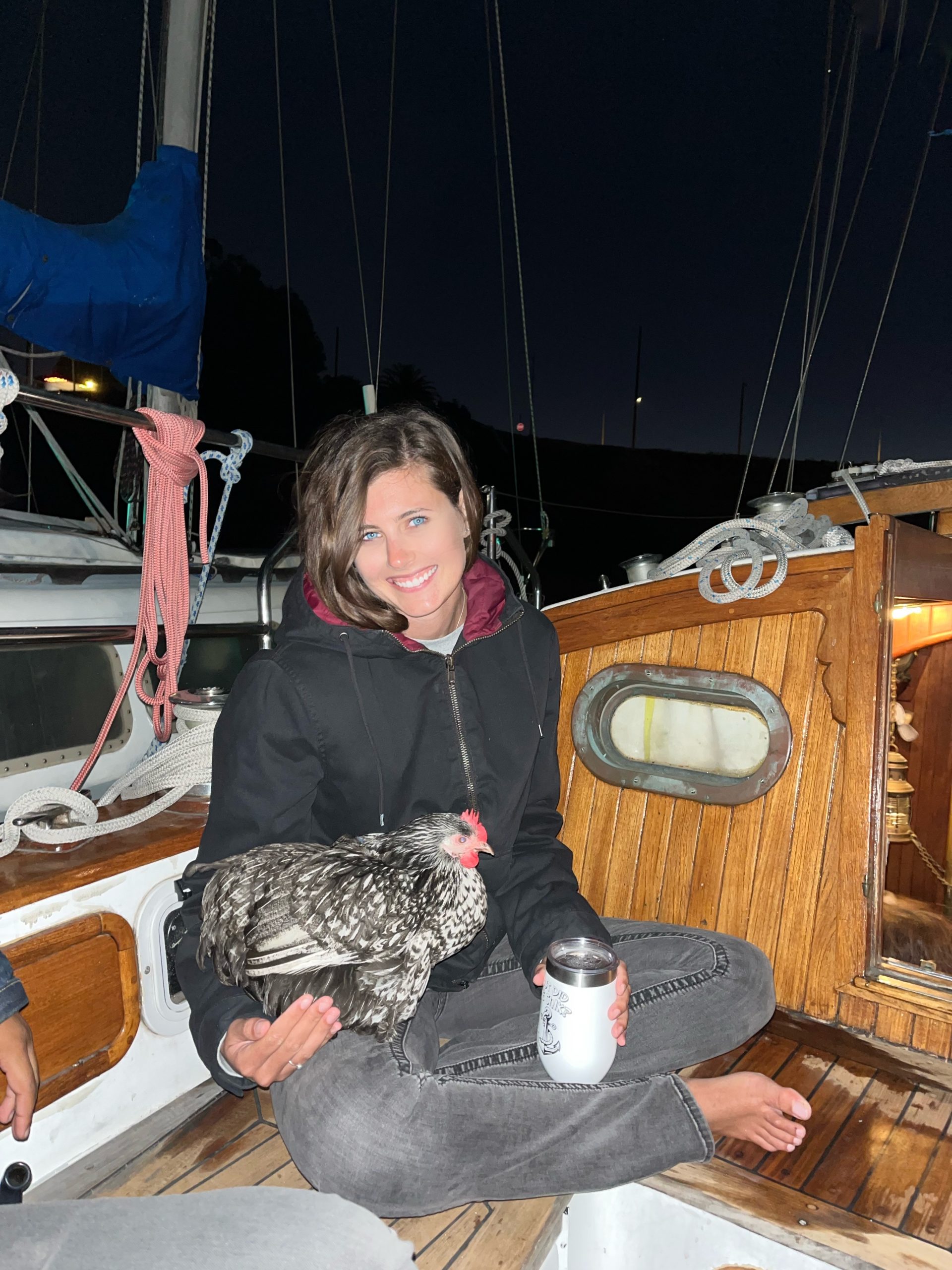 Despite all the boats in the party we found ourselves aboard a Baba 30’, a very well known stout blue water cruiser that has a lot of teak and personality resembling the likes of the Neely fleet (Avocet, Prism and Sea Castle). To my surprise the chicken that I had seen earlier, whose name was Boots, was also roosting aboard the Baba and made her way into my lap which made me a very happy sailor. The cockpit soon filled with many Washed Up Yachties, some of whom remembered Chris’s brother very well. “Jon and Shannon! Where are those guys now?” was the recurring question when someone made the connection that Chris was the younger Neely brother that also has a boat, and is also now cruising. We happily explained the whereabouts of Prism and her crew then shared our own story of why we decided to sail the wrong way and found ourselves in the cockpit of a strangers boat amongst new friends.
Despite all the boats in the party we found ourselves aboard a Baba 30’, a very well known stout blue water cruiser that has a lot of teak and personality resembling the likes of the Neely fleet (Avocet, Prism and Sea Castle). To my surprise the chicken that I had seen earlier, whose name was Boots, was also roosting aboard the Baba and made her way into my lap which made me a very happy sailor. The cockpit soon filled with many Washed Up Yachties, some of whom remembered Chris’s brother very well. “Jon and Shannon! Where are those guys now?” was the recurring question when someone made the connection that Chris was the younger Neely brother that also has a boat, and is also now cruising. We happily explained the whereabouts of Prism and her crew then shared our own story of why we decided to sail the wrong way and found ourselves in the cockpit of a strangers boat amongst new friends.
Thank you to the Washed Up Yacht Club for welcoming us; to Ashley Gremal for making an introduction via Whatsapp from Panama, to Jen for graciously hosting us aboard Sababa, to Steve for giving us valuable insight on our next destination(s) and of course to Boots for waiting to lay an egg in the cockpit after you were removed from my lap.
Bike Ride to Nowhere
Back when we were in Northern Italy, Jon was adamant that we drive just a few hours north to his favorite country, Switzerland. Reluctantly we agreed, but instead of being met with the incredible experience he was raving about we drove into a sleepy town that was pretty bland as far as European experiences go. Eventually, we found a restaurant that was open and had a round of sub-par coffees before driving back to Italy. Yes, you read that right: we drove all the way to Switzerland for a few “okay” coffees.
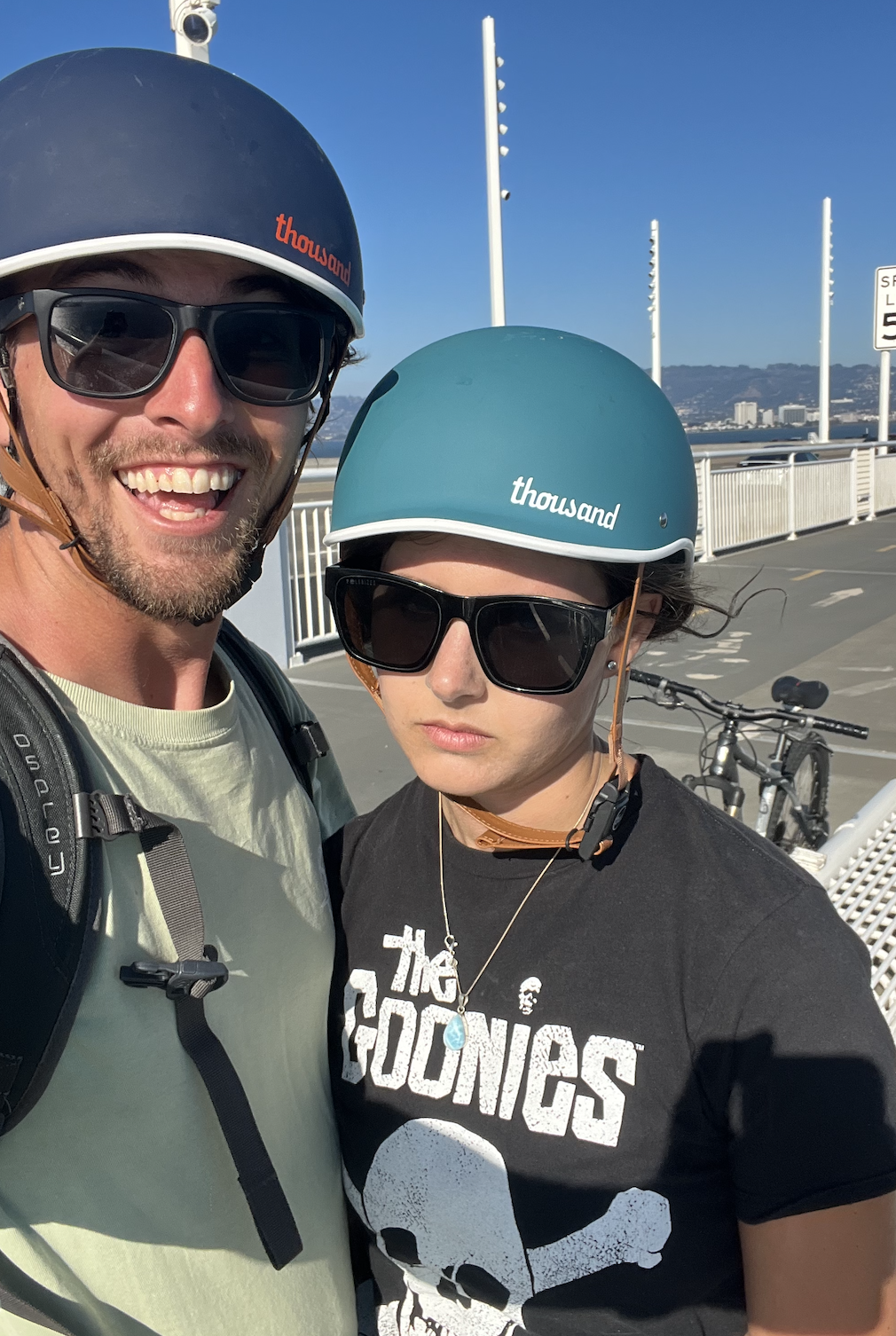
How I felt about biking in Oakland
“You pulled a Jon” I said to Chris while I took my helmet off my head in an attempt to cool down – and not just from the heat. That morning we had loaded up the dinghy with our bikes and decided to bike to Blue Pelican, a great marine consignment shop in Alameda, utilizing the Bay Bridge pedestrian path. I suppose I hadn’t expressed my distaste for biking in the city strongly enough, because instead of sticking to a designated bike path we ended up riding through the industrial side of Oakland, more specifically the second most dangerous neighborhood in the city in terms of petty and violent crime.
We had made it all the way to Jack London Square where I had refused to bike through any more sketchy neighborhoods just for a deal on a trip line buoy. “So what do we do now?” Chris asked after I let him have a piece of my mind. Blue Pelican was located another 2 miles from where we found ourselves pondering our next move, and after my tantrum we decided it was best not to risk biking through any more questionable areas. Instead of shopping for the boat we decided to shop for our stomachs at a restaurant called Souly Vegan that had vegan eats with cajun flair and live jazz music. The food was amazing but we essentially had biked 10 miles for lunch in Oakland before biking 10 miles back to Avocet empty handed – which was very reminiscent of our Switzerland story.
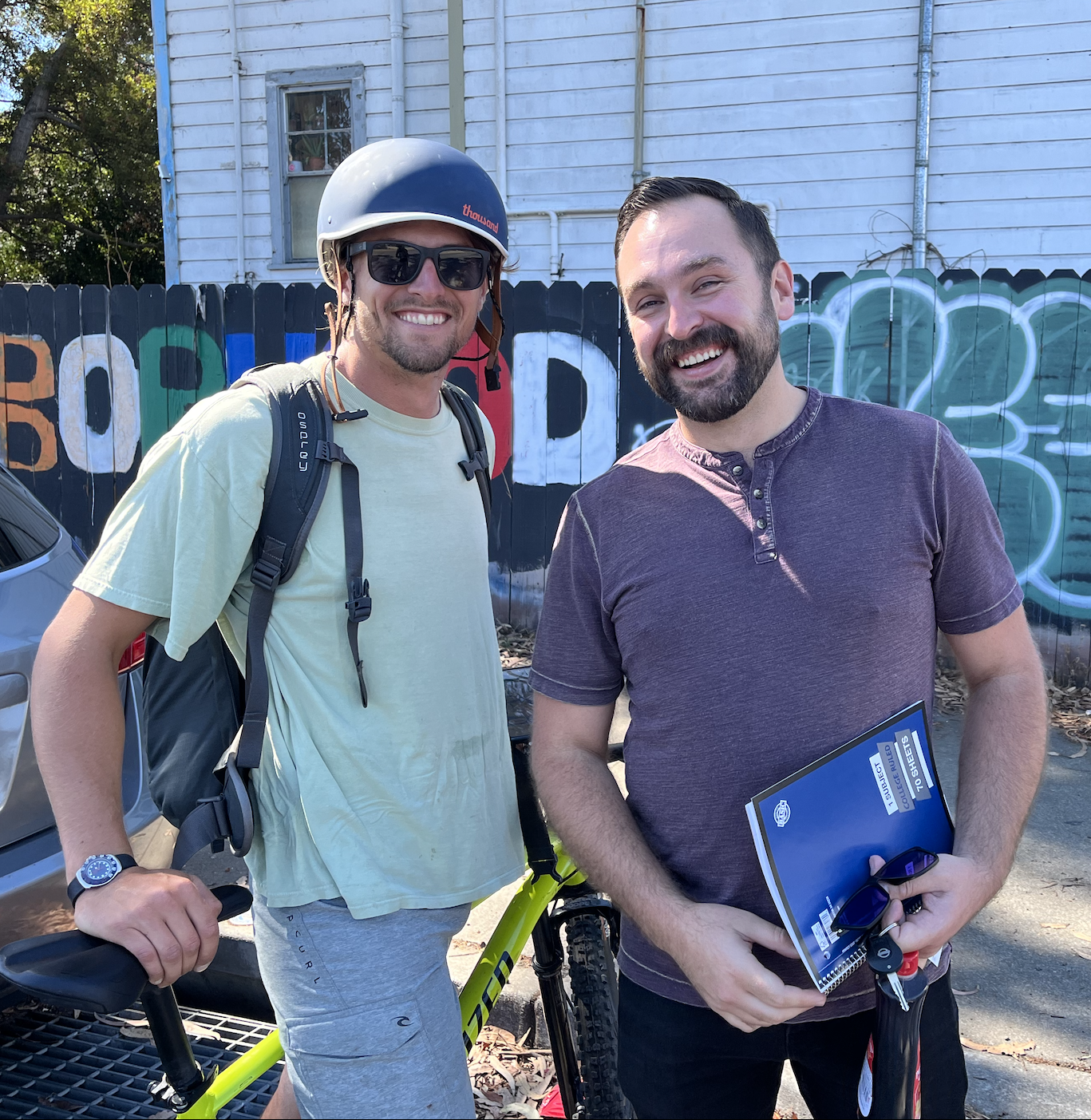
Chris and Nick
While biking along a side street we also ran into one of the stars from a TV show pilot Chris shot in 2021, which was super random and funny enough to snap a photo to commemorate the odd occurrence. After the impromptu catch-up we continued on our way back up and over the bay bridge which was quite the jaunt – Chris had to push me up part of it since my legs were giving out! Despite our failed mission we had a great workout and I got to redefine my comfort with city biking which would come in handy later.
Back aboard Avocet we dismantled the bikes and stowed them for safe keeping, slowly preparing ourselves to leave the little slice of paradise. But first, we had to get to the bottom of what the real Treasure of Treasure Island was, which all started with a simple email to the Treasure Island Museum.
The Real Treasure of Treasure Island
Given Chris’s profession as a cinematographer with emphasis on storytelling and my tenacity for chasing down a good story we were a match made in marketing heaven. When we cast off our dock lines we knew that we wanted to capture the history, beauty and future outlook of the places we visit through written word, photos and videos shared on our social pages. Treasure Island was the perfect place to put our ideas into action, so when the museum responded to my request to meet with an enthusiastic “yes” we got to work drafting questions and pulling out what video gear we needed.
Much like the rest of the island, The Treasure Island Museum is work in progress with a sign on the door stating exactly that: As redevelopment of the islands progresses, the museum will remain open and accessible. But street, parking and transit patterns will be in flux for the next few years. The large white city-official-looking building stood out against Yerba Buena’s ruggedness and Treasure Island’s urban development, and we were eager to see what treasures awaited us inside.
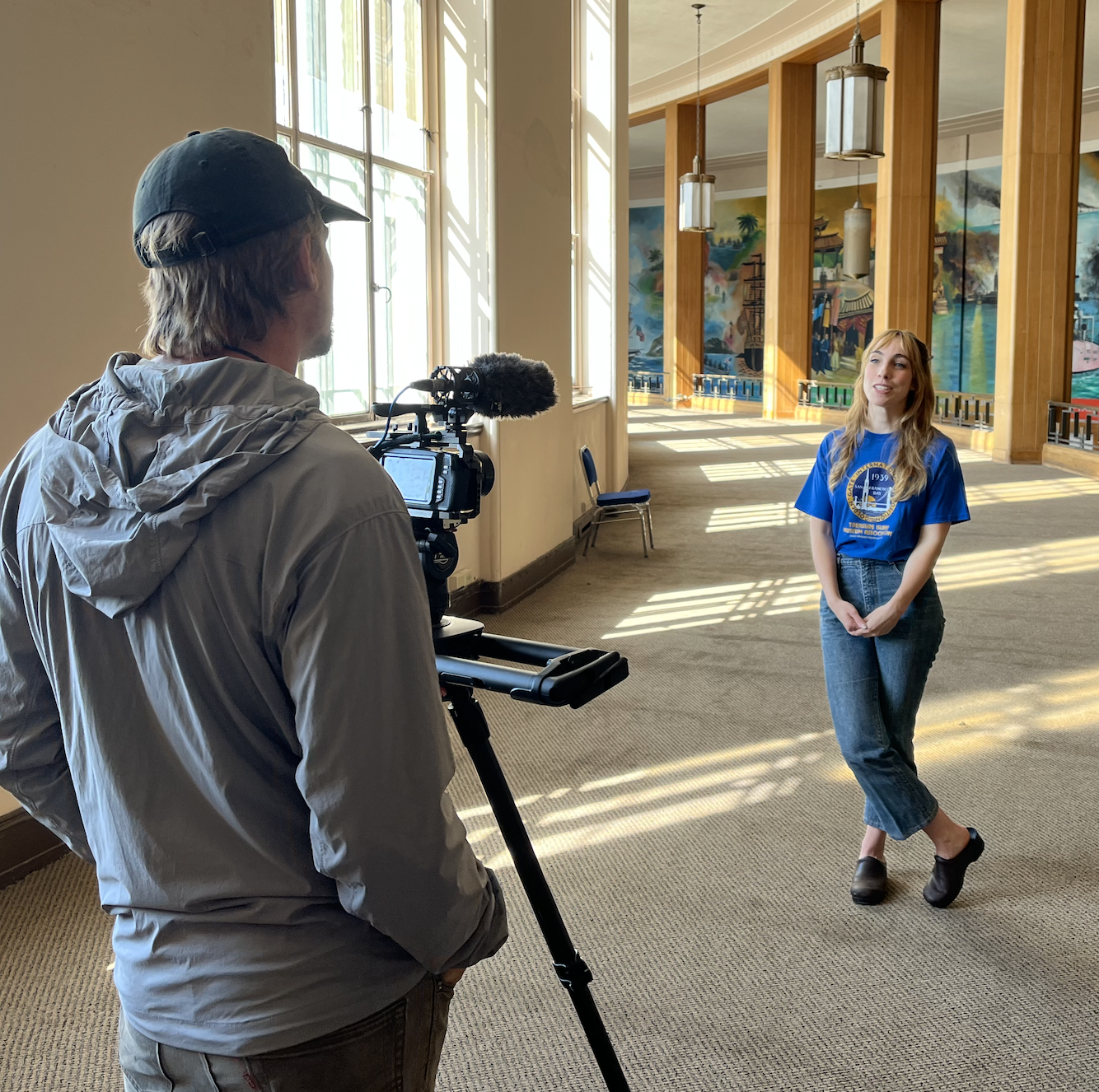 “My name is Annamarie Morel and I am the Museum Manager” the young woman stood in front of our camera and began answering our questions with the brightest smile on her face. Beforehand we had spent a few minutes scouting the best place to film in the expansive historic building that seemed to have more surface area beneath the ground than above. Yes, we toured “the basement” after I sheepishly asked if the place was haunted and Anna was kind enough to show us the ghosts’ local hangouts, which happened to be in the belly of the building where many of the rooms are still under naval jurisdiction… but we will get to that in a moment.
“My name is Annamarie Morel and I am the Museum Manager” the young woman stood in front of our camera and began answering our questions with the brightest smile on her face. Beforehand we had spent a few minutes scouting the best place to film in the expansive historic building that seemed to have more surface area beneath the ground than above. Yes, we toured “the basement” after I sheepishly asked if the place was haunted and Anna was kind enough to show us the ghosts’ local hangouts, which happened to be in the belly of the building where many of the rooms are still under naval jurisdiction… but we will get to that in a moment.
The Treasure Island Museum was founded by the Navy in 1975, occupying the lobby of one of the original airport buildings constructed in 1937-38. This Streamline Moderne “Administration Building” (known as Building One) has served through the years as the administrative center for the Golden Gate International Exposition (GGIE), a terminal and ticketing office for Pan American Airways, and headquarters for the Twelfth Naval District. The Navy/Marine Corps Museum (the “Navy museum”) opened to the public on October 3, 1975 with exhibits representing the Navy and Marine Corps in the early 1800’s to the present. Over time, the museum’s collecting and exhibiting areas evolved to include the U.S. Coast Guard as well as non-military themes: the GGIE, the Bay Bridge, Yerba Buena Island, and related subjects. As its scope expanded, the name of the museum was changed to the Treasure Island Museum. Currently the museum is focused on funding, designing and building a 3500 – 4000 square foot museum in space committed by TIDA on the ground floor of Building One. In the meantime, it plans and mount exhibits, manages a growing collection, and organizes lectures, events, and tours.
Although she had only been with the museum for a relatively short while, Anna spoke as if she had been there her whole life, indulging us in detailed answers to our many questions about the museum’s past, as well as the two island(s) that encase Clipper Cove. Much like the museum, Treasure Island has hosted a spectrum of inspiring human achievements in art, architecture, engineering and visionary national and civic endeavors starting with the creation of Treasure Island itself!
As mentioned previously, the 400 acre artificial island was built by the Army Corps of Engineers in 1936-37 on the shoals of neighboring Yerba Buena Island. The federal government paid for its construction and for three permanent buildings which would serve a potential future airport, but the original purpose of Treasure Island was to host the 1939-40 Golden Gate International Exposition. The GGIE was a glowing Art Deco “Magic City” of towers, gardens, goddesses, and dazzling lighting effects created to celebrate the ascendency of California and San Francisco as economic, political, and cultural forces in the Pacific region.
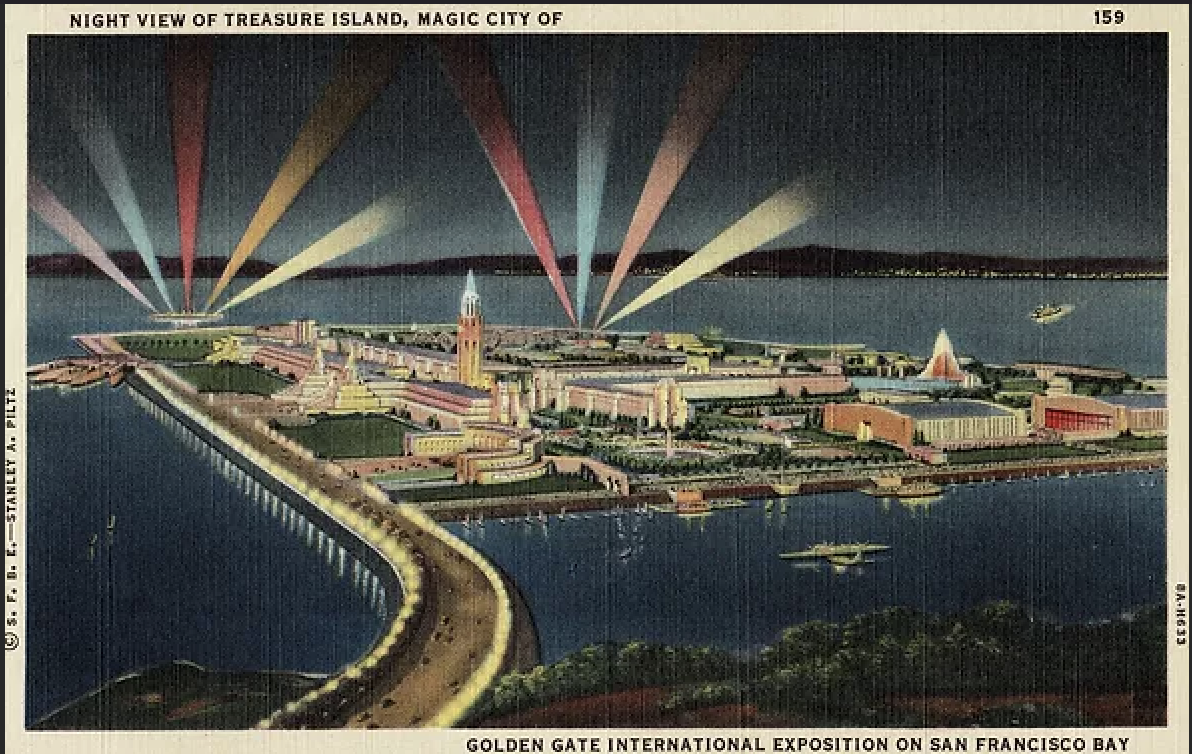
Post card from the GGIE – image curtsy of the Treasure Island Museum
The fair also celebrated the local engineering achievements of the Golden Gate and San Francisco-Oakland Bridges and the birth of transpacific air passenger service with the advent of the Pan American Airways Clippers. The fair billed itself optimistically as “A Pageant of the Pacific.”
As the United States prepared for WWll in 1941, the U.S. Navy moved onto Treasure Island, transforming it into a major training and education center. Millions of personnel were shipped overseas following their training from Treasure Island. By the time the war ended in 1945, aviation had changed dramatically; the Pan Am Clippers were no longer in regular service, so the island was never developed as an airport.
The Treasure Island Naval Station was closed in 1997 and leased to the City of San Francisco. Shortly afterwards, the enormous hangar buildings were converted to sound stages for feature films such as The Matrix, Parent Trap, Indiana Jones and television shows such as Nash Bridges and Discovery Channel’s Prototype This!
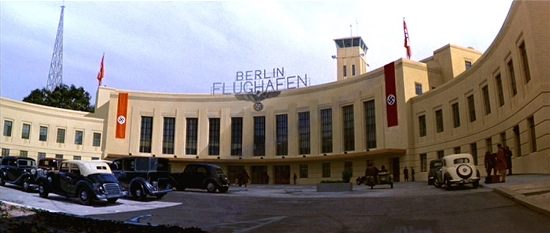
The building was featured in Indiana Jones as a nazi Headquarters – the swatztikas were added later to not upset the Bay Area inhabitants
Treasure and Yerba Buena Islands are now in the beginning stages of a sustainably designed redevelopment project which will create up to 8,000 residences, open space across three-fourths of TI and much of YBI, and a compact mixed-use commercial center serving island residents. The Clinton Climate Initiative (C40) designated the redevelopment plan as one of only 19 model Climate Positive Projects worldwide. It was awarded LEED-ND Platinum certification, becoming only the 17th in the world to receive the highest designation possible for a green, sustainable development. The American Institute of Architects honored it as a “new urban ecology with innovative sustainable strategie.” Hopefully the artificial island will soon become a destination for Bay Area residents and tourists from around the world to enjoy waterfront promenades that will display public art and offer spectacular views of San Francisco and the Bay.
“So… that’s basically it!” Anna said through a cheery wide grin. We thought it best not to address the questions about the Navy’s (literal) toxic legacy given that the island is so eager to make positive change for not only its residents but also its future visitors. Of course the past cannot be ignored, but the island’s dedication to improvement is admirable and worth celebrating, not something we want to soil by focusing on such a detrimental time in history. After our interview Anna introduced us to Atta Pilram, island resident, museum board member and the Treasure Island Yacht Club commodore who was kind enough to take the time to chat with us about sailing in the bay and show us the club.
The yacht club was located down stairs, with large windows that looked out over Clipper Cove. “There’s Avocet” I pointed to our boat that sat patiently awaiting us in the anchorage. While Chris chatted with Atta about our sailing plans I flipped through the club’s collection of magazines hunting for the latest edition of Cruising World where I hoped to find my most recent publication. Instead, I found the Spring 2022 edition of Latitudes and Attitudes that featured yours truly on the cover. “I didn’t realize we were in the presence of celebrities!” Atta flattered us, but I was truly just proud to see my published work in a yacht club far from where I had originally submitted it – proving how close knit the sailing community really is. Inside the magazine I stuck an Avocet QR code sticker, which I often use for geocaching, as my way of saying “I was here!”
Before we bid our new friends adieu, Atta gifted Chris a Treasure Island Yacht Club hat that he would proudly wear around the bay for the next few weeks before sailing back under the Golden Gate.
So, what is the treasure on Treasure Island? Perhaps it was originally the alleged gold in the soil used to resurrect the island, or maybe sadly the radioactive isotopes, but today Chris and I think that the real treasure lies within the hearts of the people who keep the history alive and continue to fight for healthy progress, who will undoubtedly turn the island into a gem of the San Francisco Bay.
Pulling Anchor
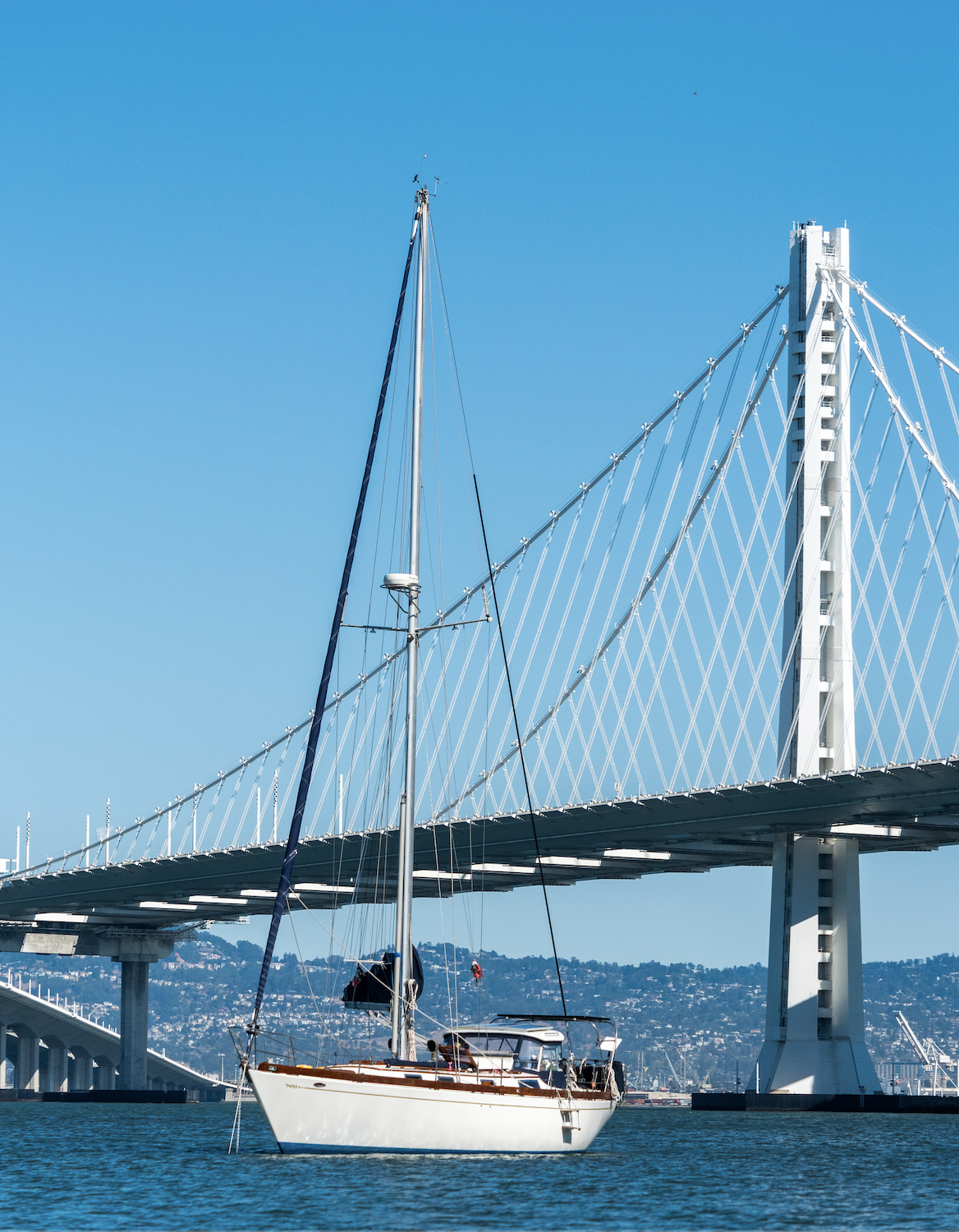 Our crew of three spent eight days anchored in Clipper Cove, which was longer than expected but all for good reasons. It was protected, easy to get to shore, and a relaxing start to our cruising journey but we knew that it was time to move on to the next adventure. The islands shrank off our stern as we set our course for our new anchorage; another island just west of Treasure Island where we planned to rendezvous with our new friends from Chalet Mer. We never would have guessed that it would feel so much like our beloved Santa Cruz Island in the south, but that’s a story for the next blog post.
Our crew of three spent eight days anchored in Clipper Cove, which was longer than expected but all for good reasons. It was protected, easy to get to shore, and a relaxing start to our cruising journey but we knew that it was time to move on to the next adventure. The islands shrank off our stern as we set our course for our new anchorage; another island just west of Treasure Island where we planned to rendezvous with our new friends from Chalet Mer. We never would have guessed that it would feel so much like our beloved Santa Cruz Island in the south, but that’s a story for the next blog post.
Thank you, dear reader, for making it this far and supporting our cruising journey. It has been a long time coming and we are excited to cash in our hard work for adventure, and take you along for the ride. Be sure to follow us on YouTube, Instagram, and Facebook to stay up to date with our latest whereabouts, and if you enjoyed reading this blog please do share it with your friends! Every view helps.
Until next time… Fair winds,
Marissa (and Chris and Cleo)
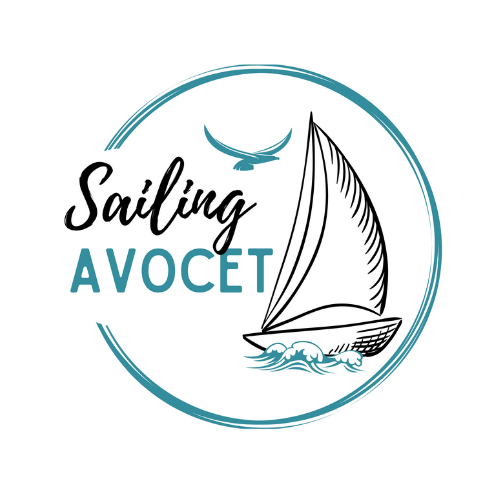
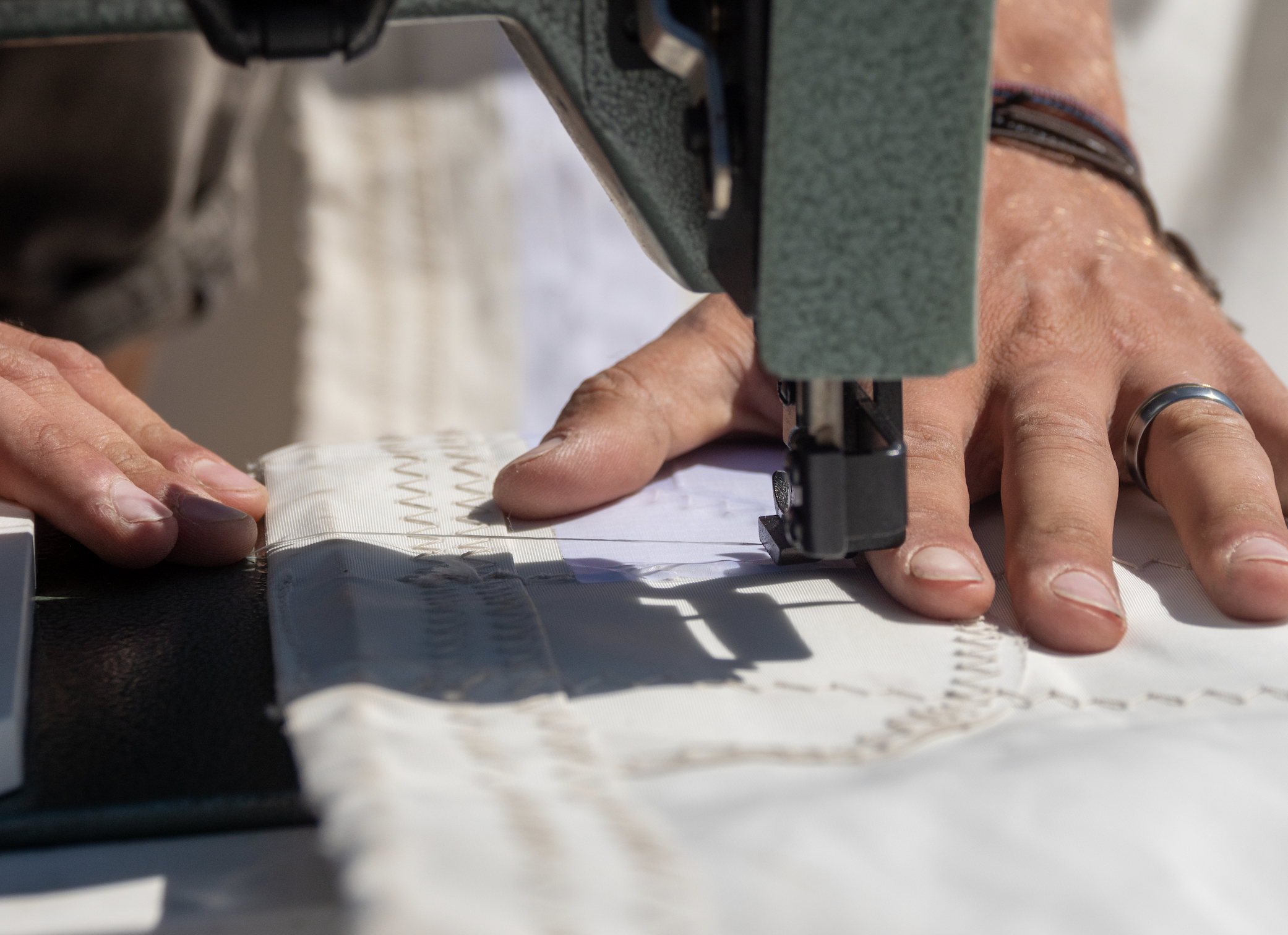
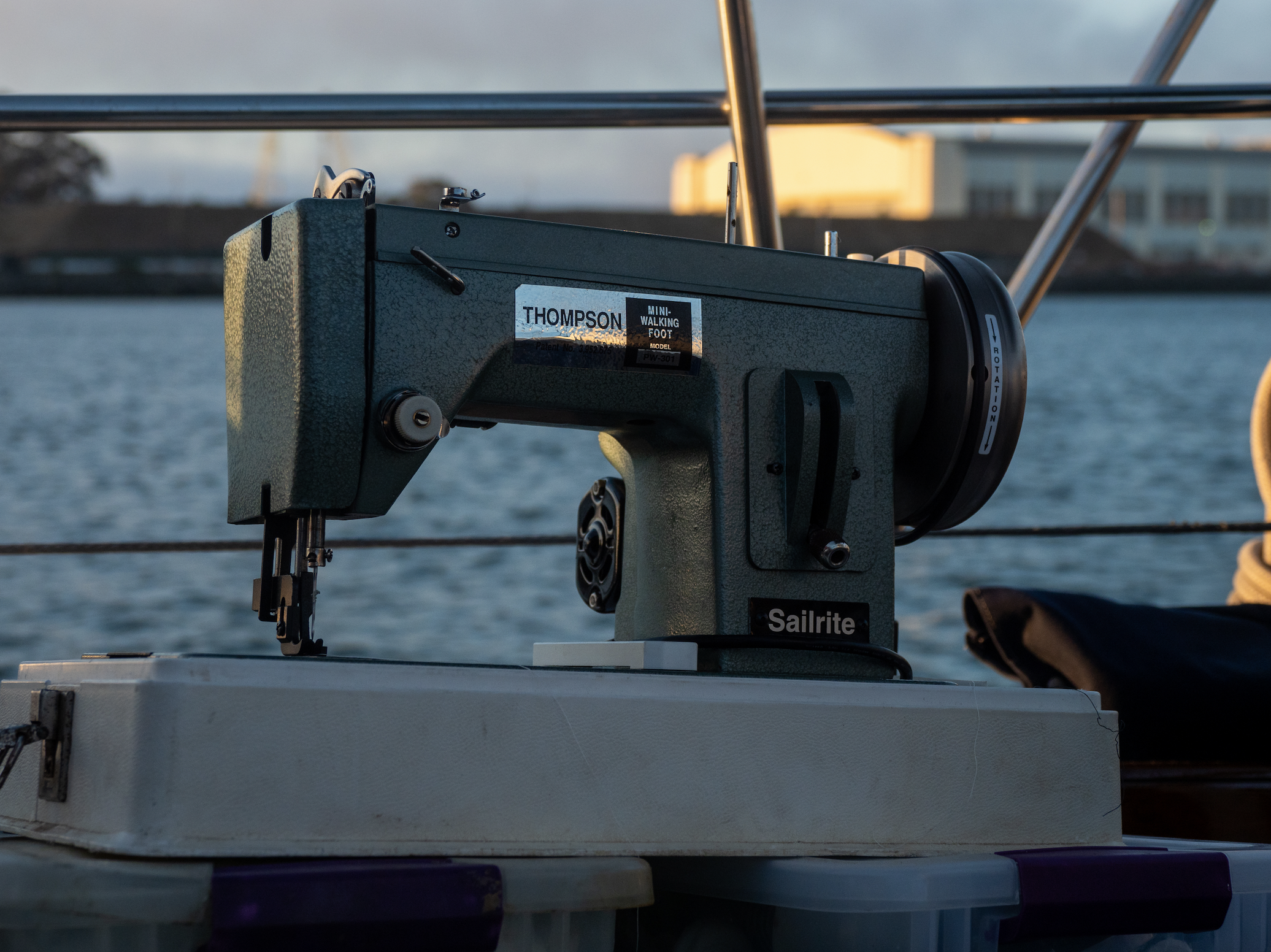
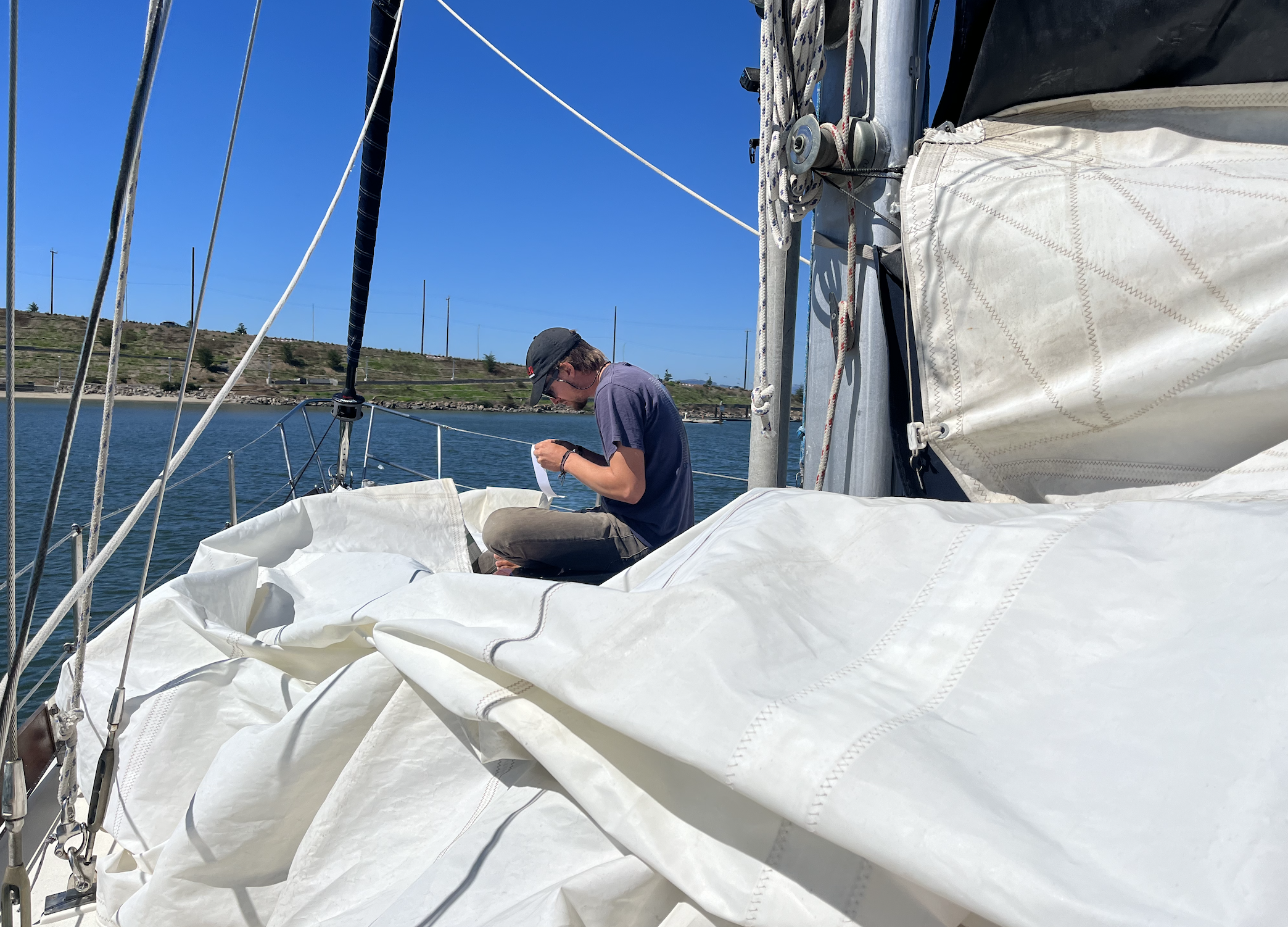


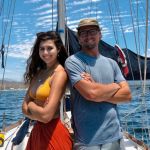




0 Comments